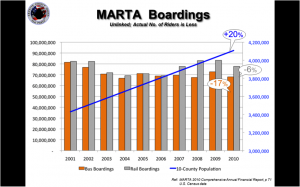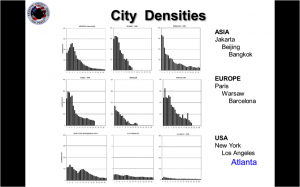
Debunking the Myths: Part 1 – Congestion
Debunking the Myths: Part 1 – Congestion
The myth: building rail transit will take cars off the road and relieve congestion.
This is the oft-quoted rationale for building rail transit. It sounds good. Anyone who is stuck in the logjam of GA400, I-75 or I-85 hears this myth with great anticipation. Getting everyone else off of the road so that I can travel freely is a desirable outcome.
The problem is that everyone else feels the same way. Someone else is supposed to stop driving and take rail transit to work.
The fact is that less than 5% of commuters are using transit, and MARTA ridership has been declining. Even the proponents of rail transit in ARC take their private cars to every meeting.
Other facts:
- MARTA takes more time, even in rush hour. By the time a passenger makes the 10 stops from downtown to the North Springs station, perhaps waiting to change trains at Lindbergh, the trip normally takes more time than driving.
- The overwhelming number of people who work out of the few offices reachable by rail transit do not stay in their offices all day. The average high-rise office in metro Atlanta has 33 people (Source: Cypress Communications, 2000). Of those, many more do business outside their own office than inside. Atlanta is primarily a sales and distribution city.
- The metro Atlanta area is 60 miles wide and 70 miles long. We are not bounded by any geographic limits. Our population density therefore is not nearly the same as other cities that make more effective use of transit. The following charts show clearly why rail transit in metro Atlanta won’t work. These charts show the density per square mile as you move away from city centers. Jakarta, Beijing, Bangkok and Paris have very high densities close to their city centers.
Atlanta, relatively speaking, has virtually no density in the city center. Unless we wish to transition the entire metro region into Beijing-like high density offices and housing, rail transit will never take many cars off of the road. While Cousins, Dewberry and the other high-rise developers might like us all to live in their projects, most Atlanta residents treasure their suburban lifestyle and would move elsewhere rather than live in high-density housing.
“Atlanta has the nicest suburbs of any city
in America. We should promote them and make
them work better, not try to ‘fix’ them.”
Atlanta ceased to be a hub-and-spoke city 30 years ago. We have become a region of clusters, with travel patterns between the clusters. People want to go from Marietta to Alpharetta, and from Roswell to Duluth. We should be finding ways to analyze the entire region on an origin-destination basis and improve the arteries that will help get us to where we want to go, and stop dumping money into rail transit.
4. The current TSPLOST project list completely ignores the massive movement of truck freight into, through and around Atlanta. With the deepening of the Savannah port, and the new generation of container ships coming in the next several years, this traffic will continue to increase. Speaking at the Georgia Public Policy Foundation Legislative Policy Briefing on Sept. 30, 2011, Ed Crowell of the Georgia Motor Trucking Association was asked his opinion of the TSPLOST projects. His response: “Looking at the most recent project list, we don’t find anything that will reduce congestion.”
The entire HB277-specified approach to transportation planning is deeply flawed. It imposes an enormous tax increase, it fails to yield professional transportation planning, and creates political mayhem across the region, with every mayor grabbing for the honey pot of new revenue for their pet projects. The General Assembly should repeal the entire bill and start over by fixing the original problem: a dysfunctional DOT. We should elect our DOT representatives, we should mandate that all projects be designed to reduce congestion and we should establish and fund an entire department to do nothing but identify and evaluate innovations in transportation design and traffic management. If they don’t, we strongly urge everyone to vote against the T-SPLOST.
– Mike Lowry
About Mike Lowry
Mr. Lowry brings a diverse background of entrepreneurial start-ups, software and other technology development, IT management and sales to his current activity as a start-up mentor at ATDC. Mr. Lowry is also active in the Alpharetta Rotary Club, with a focus on international projects and assisting homeless teens complete high school.
Mr. Lowry also speaks in support of the Fair Tax and is active in community affairs. Specialties include business plan development, marketing and sales strategy, technology implementation and integration.







